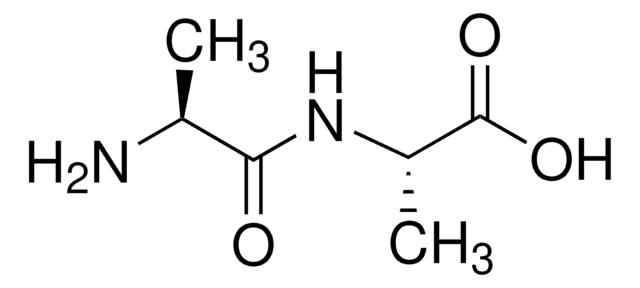G8541
Ala-Gln
200 mM, solution, sterile-filtered, Biotechnology Performance Certified
Synonyme(s) :
Alanyl-glutamine, Glutamine-S
About This Item
Produits recommandés
Qualité
Biotechnology Performance Certified
Niveau de qualité
Stérilité
sterile-filtered
Forme
solution
Concentration
200 mM
Impuretés
endotoxin, tested
Température de stockage
2-8°C
Chaîne SMILES
NC(CC[C@H](NC([C@@H](N)C)=O)C(O)=O)=O
InChI
1S/C8H15N3O4/c1-4(9)7(13)11-5(8(14)15)2-3-6(10)12/h4-5H,2-3,9H2,1H3,(H2,10,12)(H,11,13)(H,14,15)/t4-,5-/m0/s1
Clé InChI
HJCMDXDYPOUFDY-WHFBIAKZSA-N
Vous recherchez des produits similaires ? Visite Guide de comparaison des produits
Description générale
Application
Autres remarques
Code de la classe de stockage
10 - Combustible liquids
Classe de danger pour l'eau (WGK)
WGK 1
Point d'éclair (°F)
Not applicable
Point d'éclair (°C)
Not applicable
Certificats d'analyse (COA)
Recherchez un Certificats d'analyse (COA) en saisissant le numéro de lot du produit. Les numéros de lot figurent sur l'étiquette du produit après les mots "Lot" ou "Batch".
Déjà en possession de ce produit ?
Retrouvez la documentation relative aux produits que vous avez récemment achetés dans la Bibliothèque de documents.
Les clients ont également consulté
Articles
Importance and uses of glutamine in hybridoma and mammalian cell culture
Organoid culture products to generate tissue and stem cell derived 3D brain, intestinal, gut, lung and cancer tumor organoid models.
Notre équipe de scientifiques dispose d'une expérience dans tous les secteurs de la recherche, notamment en sciences de la vie, science des matériaux, synthèse chimique, chromatographie, analyse et dans de nombreux autres domaines..
Contacter notre Service technique








